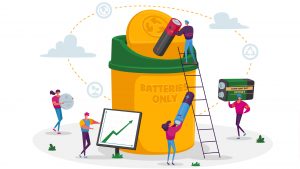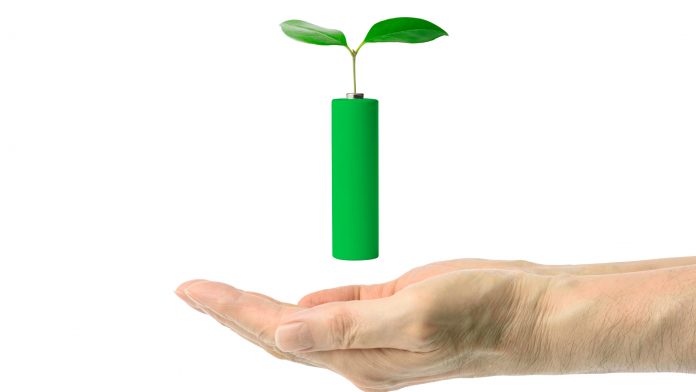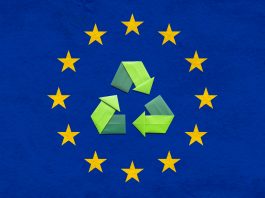Vivian Loonela, Coordinating Spokesperson for the European Green Deal, speaks to The Innovation Platform about the importance of modernising the EU’s legislation to achieve sustainable batteries.
Sustainable batteries will play a critical role as Europe endeavours to reach its carbon neutral goals and deliver the targets set out in the European Green Deal. By 2050, the EU is aiming to cut its net greenhouse gas emissions to zero which will necessitate a complete overhaul of the renewable energy market. The transportation industry, of which road transport constitutes the greatest proportion of overall transport emissions (around 71% in 2018), is set to undergo a shift towards e-mobility, promoting the use of zero and low emission vehicles and optimising the implementation of efficient and affordable battery technologies. As part of the EU’s budget for 2021 to 2027, €30.6bn will be invested in the transportation sector, a portion of which will support research and development in battery technologies, a market that is expected to be worth around €250bn by 2025.
Supporting the development and production of sustainable batteries used for electric vehicles and other green applications is integral to the EU’s green energy transition and lithium-ion batteries will be a key driver on the road to more sustainable modes of transport. While the affordability of lithium-ion batteries will help the energy storage market to grow, lithium was recently added to the European Commission’s list of critical raw materials due to its high supply risk. Assessing the EU’s dependency on raw materials used in the energy storage market and establishing a circular economy for batteries at home will therefore be paramount moving forwards. In December last year, the EU Commission published an updated regulatory framework for batteries which focused on the importance of establishing a circular supply chain in order to ensure the batteries within the EU market are safer and more sustainable. It is estimated that 800,000 tons of automotive batteries, 190,000 tons of industrial batteries, and 160,000 tons of consumer batteries enter the European Union every year. Reflecting on the EU’s new legislation for batteries, Vivian Loonela, Coordinating Spokesperson for the European Green Deal, speaks to The Innovation Platform about how this new regulatory framework will support the sustainable production, deployment and waste management of all batteries.
Why was it important to modernise the EU’s legislation on batteries and how will this proposal complement other regulatory frameworks already in place?
The global demand for batteries is set to increase 14 fold by 2030, and the EU could account for 17% of that demand. This exponential growth will lead to an equivalent increase in demand for raw materials, which will have a significant environmental impact. The growing use of batteries will also lead to surging amounts of waste.
To ensure that the expected massive deployment of batteries does not hamper our efforts in the green transition, the EU must take action for the sustainable production, deployment and waste management of all batteries placed on the EU market. The existing 2006 Batteries Directive is no longer up to date. New socioeconomic conditions, technological innovations, markets, and battery uses have emerged.
The new Regulation will be a forward-looking instrument, laying down a harmonised regulatory framework addressing all life cycle stages. Ensuring consistency and synergies with other pieces of EU legislation has been and continues to be a goal for the Commission. This may refer to instances where parts of the regulatory framework will be set by other instruments, such as type-approval legislation, or where close waste streams are regulated specifically and individually, as the End-of-Life Vehicles Directive.
Where do you see the greatest challenges arising in the implementation of this new batteries framework? For instance, how can the new Regulation support the ethical sourcing of raw materials while encouraging research and innovation within the battery industry?
A new batteries policy requires a new strategic approach, to which this proposal represents a significant contribution. The Commission proposes a regulation defining new types of requirements covering all life cycle stages of the battery and obligations for all actors in the battery value chain, which entails new enforcement challenges.
This is the case regarding ethical sourcing: it is socially, environmentally, and ethically unacceptable that our decarbonisation occurs at the expense of developing regions where these raw materials are sourced and processed. In this respect, the proposal contains two elements to help. First, manufacturers and importers have to arrange verification and notification systems. Second, authorities concerned will benefit from the proposal’s Electronic Exchange System.
This system, complemented by a Battery Passport, is the digital backbone of the proposal. It will include information on each electric vehicle model and industrial battery related to the various requirements of the proposal.
The proposal assumes that important developments in the battery value chain will happen in the near future and proposes a realistic calendar to complete the operational framework for implementing the new Regulation and the industry to modify their production.
How will the proposed Regulation support the establishment of a full batteries value chain in the EU and ensure the EU is able to compete effectively with global markets?
Indeed, batteries are an excellent example where environment and competitiveness work hand in hand. Europe’s rapidly emerging battery value chain is of strategic importance for Europe’s economy and, at the same time, it will help drive a green recovery.
The proposal takes the life-cycle approach to products’ regulation, and its scope covers the issues that the Commission proposes to tackle, including economic ones. Only a strong and well-functioning EU market for batteries, waste batteries and secondary materials will make it possible to ensure the sustainability and the competitiveness of the EU battery value chain.
Setting both policy principles and detailed rules at EU level, will result in a more efficient battery value chain and market. The new Regulation should allow industrial actors to capture the opportunities arising from the EU market’s expected growth, promoting innovation and competitiveness, increasing environmental protection, and contributing to the wise management of natural resources. This also means jobs and prosperity.
By proposing this regulation, the Commission intends to promote globally sustainable battery value chains, leading by example and establishing a blueprint for other sustainable product policies.
Which European countries have made the greatest progress in terms of battery technologies at present?
This is a difficult to answer as there is major private and public investment going into battery technologies throughout the EU and technologies are developing at a very fast pace.
In 2019 and 2020, the Commission, through the previous Horizon 2020 research framework programme, has financed 39 innovative battery projects with funding of €266m. The new Horizon Europe programme has created a new Batteries Partnership, which will bring together all Horizon Europe funding for batteries into a single targeted programme that covers all aspects of the value chain. Its focus is on battery technology and manufacturing process development for both e-mobility and stationary storage.
Furthermore, the Commission has approved, under State aid rules, two Important Projects of Common European Interest (IPCEIs) to support research and innovation across the battery value chain.
- In 2019, the Commission approved €3.2bn in public support by seven Member States (France, Germany, Sweden, Belgium, Finland, Poland and Italy) for a first pan-European research and innovation project in all segments of the battery value chain. The project involves 17 direct participants, mostly industrial actors, including SMEs; and
- On 26 January, the Commission approved, under EU State aid rules, a second IPCEI to support research and innovation in the battery value chain. The project, entitled ‘European Battery Innovation’ was jointly prepared and notified by twelve Member States (Austria, Belgium, Croatia, Finland, France, Germany, Greece, Italy, Poland, Slovakia, Spain and Sweden). It involves 42 direct participants, including SMEs and start-ups with activities in one or more Member States.
In total, for these two battery IPCEIs, a maximum of €6bn State aid by the participating Member States was approved, which is expected to unlock approximatively €14bn in additional private investments.

The projects cover the entire battery value chain from extraction of raw materials to recycling and disposal in a circular economy, with a strong focus on sustainability.
More information on battery projects and companies involved in battery technologies can be found on the InnoEnergy website, which supports the industrial aspects of the Commission’s European Battery Alliance initiative: https://www.eba250.com/about-eba250/benefits/
Electric transportation is a driving factor in achieving the European Green Deal, what other sectors are driving the growth towards a green economy?
Achieving 55% greenhouse gas emissions reductions will require action in all sectors of the economy. A climate-neutral transition can only be accomplished with contributions from everyone. CO2 emissions from the burning of fossil fuels are the largest source of greenhouse gas emissions in the EU. Together with fugitive non-CO2 emissions in the energy system, they are responsible for just over 75% of EU greenhouse gas emissions. This underlines the energy system’s central role in the transition to a climate neutral economy. Buildings and transport are, alongside industry, the main energy users and source of emissions. Decarbonising both energy supply and demand is key to achieving climate neutrality.
Vivian Loonela
Coordinating spokesperson for the European Green Deal
EU Commission
https://ec.europa.eu/info/index_en
Please note, this article will also appear in the sixth edition of our quarterly publication.





